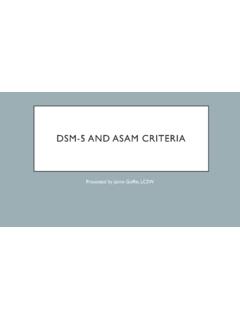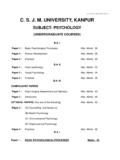Transcription of Pretest Questions - ICADD
1 What's New and How to Use The ASAM Criteria: david Mee-Lee, Skill-Building in Implementing the New Edition What's New and How to Use The ASAM Criteria: Skill-Building in Implementing the New Edition david Mee-Lee, Davis, CA. (530) 753-4300; Voice Mail (916) 715-5856. May 12, 2014 9 AM 4:45 PM ICADD , Boise, Idaho A. Pretest Questions Select the Best Answer: 1. The best treatment system for addiction is: (a) A 28-day stay in inpatient rehabilitation with much education. (b) A broad continuum of care with all levels of care separated to maintain group trust. (c) Not possible now that managed care has placed so much emphasis on cost-containment. (d) A broad range of services designed to be as seamless as possible for continuity of care. (e) Short stay inpatient hospitalization for psychoeducation. 2. The six assessment dimensions of the ASAM Criteria: (a) Help assess the individual's comprehensive needs in treatment.
2 (b) Provide a structure for assessing severity of illness and level of function. (c) Requires that there be access to medical and nursing personnel when necessary. (d) Can help focus the treatment plan on the most important priorities. (e) All of the above. 3. A multidimensional assessment in behavioral health treatment: (a) Should include psychosocial factors such as readiness to change. (b) Is ideal, but not necessary within a managed care environment. (c) Should include biomedical and psychiatric problems, but not motivation or relapse potential. (d) Is best done after detoxification is completed. (e) Should be completed by the primary therapist only. 4. Assessment of motivation and goals is important to: (a) Match treatment to the client's readiness to change. (b) Ensure residential care is not wastefully utilized. (c) Avoid confrontational approaches that alienate the client.
3 (d) Individualize the referral and treatment plan. (e) All of the above. 5. To ask a consumer what s/he really wants: (a) Is unnecessary as their judgment is so poor. (b) Is as important as assessing what the consumer needs. (c) Gives a false impression that they should have choice about treatments (d) Leads to disrespect of the clinician's authority and expertise. (e) Usually reveals unrealistic goals that should be ignored.. The Change Companies 1 What's New and How to Use The ASAM Criteria: david Mee-Lee, Skill-Building in Implementing the New Edition 6. The 2013 edition of the ASAM Criteria includes: (a) Changing all the Admission Criteria for all the levels of care. (b) New sections on sex and internet addiction. (c) Adding sections on the application of Criteria to older adults and parents with children. (d) Changing the names of the six assessment dimensions of The ASAM Criteria.
4 7. The ASAM Criteria was updated for the following reasons: (a) To improve application of the criteria to special populations. (b) To make the book more user-friendly to counselors and clinicians. (c) To incorporate new diagnostic admission criteria compatible with DSM-5. (d) All of the above 8. ASAM's Definition of Addiction is incorporated in the new edition as follows: (a) It provides guidelines to have all addiction services be provided by addiction physicians. (b) It encourages using all the levels of care for chronic disease management of addiction. (c) It describes addiction as an acute care illness that makes Dimensions 1, 2 and 3 paramount. (d) It requires all patients to have a chaplain involved for the spiritual aspects of treatment. 9. Changes in the new edition include: (a) Changing the designation of levels of care from Arabic numbers to Roman numerals.
5 (b) New sections on Gambling Disorder and Tobacco Use Disorder. (c) Merging all the adolescent criteria into the adult criteria. (d) Adding an assessment dimension on spirituality. 10. In an era of health care reform: (a) The ASAM Criteria's primary goal is to keep addiction separate and safe from mental health. (b) Accountable care organizations and health homes will pay attention to addiction even less now. (c) The ASAM Criteria can help integrate addiction into general healthcare. (d) None of the above 11. The true spirit and content of The ASAM Criteria ensures that: (a) All withdrawal management occurs in a medically-monitored level to provide maximum safety. (b) The length of stay is variable depending on the severity of illness and the patient's progress. (c) The patient stays and graduates from each level of care as determined by the primary counselor.
6 (d) Long-term residential treatment is always necessary if the client lives in a toxic environment. 12. The following terminology changes are made in The ASAM Criteria: (a) Patient Placement was removed in the book title, as the book no longer has placement criteria. (b) Opioid Maintenance Therapy (OMT) was changed to Office-Based Opioid Treatment (OBOT). (c) Merging all the adolescent criteria into the adult criteria. (d) Detoxification changed to Withdrawal Management . The liver detoxifies, but clinicians manage withdrawal.. The Change Companies 2 What's New and How to Use The ASAM Criteria: david Mee-Lee, Skill-Building in Implementing the New Edition Indicate True or False: T F. 13. It is not the severity or functioning that determines the treatment plan, but ( ) ( ). the diagnosis, preferably in DSM terms. 14. Gambling Disorder is in DSM-5 and the new ASAM Criteria.
7 ( ) ( ). 15. There are six broad levels of care in the ASAM Criteria ( ) ( ). 16. Dimension 5 focuses on internal attitudes, beliefs and coping skills to ( ) ( ). deal with relapse. 17. A diagnosis is necessary, but not sufficient to determine level of care. ( ) ( ). 18. The level of care placement is the first decision to make in the assessment ( ) ( ). 19. Dimension 4, Readiness to Change, applies only to motivation for abstinence ( ) ( ). 20. The Tobacco Use Disorder section encourages all programs to become tobacco-free. ( ) ( ). 21. In criminal justice populations, it is important to ensure patients do treatment not ( ) ( ). do time just focused on how long they have to stay. 22. The ASAM Criteria helps increase access to care and use resources efficiently. ( ) ( ). 23. The co-occurring disorders section added a complexity capable description. ( ) ( ).
8 24. Clients in early stages of change need relapse prevention strategies ( ) ( ). B. Underlying Principles and Concepts of the ASAM Criteria 1. Generations of Clinical Care (a) Complications-driven Treatment No diagnosis of Substance Use Disorder Treatment of complications of addiction with no continuing care Relapse triggers treatment of complications only No diagnosis Treatment of complications No continuing care Relapse (b) Diagnosis, Program-driven Treatment Diagnosis determines treatment Treatment is the primary program and aftercare Relapse triggers a repeat of the program Diagnosis Program Aftercare Relapse . The Change Companies 3 What's New and How to Use The ASAM Criteria: david Mee-Lee, Skill-Building in Implementing the New Edition (c) Individualized, Clinically-driven Treatment PATIENT/PARTICIPANT ASSESSMENT. Data from all BIOPSYCHOSOCIAL. Dimensions PROGRESS PROBLEMS/PRIORITIES.
9 Response to Treatment BIOPSYCHOSOCIAL Severity (SI). BIOPSYCHOSOCIAL Severity (SI) and Level of Functioning (LOF). and Level of Functioning (LOF). PLAN. BIOPSYCHOSOCIAL Treatment Intensity of Service (IS) - Modalities and Levels of Service (d) Client-Directed, Outcome-Informed Treatment PARTICIPANT ASSESSMENT. Data from all BIOPSYCHOSOCIAL. Dimensions PROGRESS PROBLEMS or PRIORITIES. Treatment Response: Build engagement and alliance working Clinical functioning,psychological, with multidimensional obstacles inhibiting social/interpersonal LOF the client from getting what they want. Proximal Outcomes , Session What will client do? Rating Scale; Outcome Rating Scale PLAN. BIOPSYCHOSOCIAL Treatment Intensity of Service (IS) - Modalities and Levels of Service 2. Assessment of Biopsychosocial Severity and Function (The ASAM Criteria 2013, pp 43-53). The common language of six ASAM Criteria dimensions determine needs/strengths in behavioral health services: 1.
10 Acute intoxication and/or withdrawal potential 2. Biomedical conditions and complications 3. Emotional/behavioral/cognitive conditions and complications 4. Readiness to Change 5. Relapse/Continued Use/Continued Problem potential 6. Recovery environment . The Change Companies 4 What's New and How to Use The ASAM Criteria: david Mee-Lee, Skill-Building in Implementing the New Edition Assessment Dimensions Assessment and Treatment Planning Focus 1. Acute Intoxication and/or Assessment for intoxication and/or withdrawal management. Withdrawal Withdrawal Potential management in a variety of levels of care and preparation for continued addiction services Assess and treat co-occurring physical health conditions or complications. 2. Biomedical Conditions and Treatment provided within the level of care or through coordination of Complications physical health services 3.



